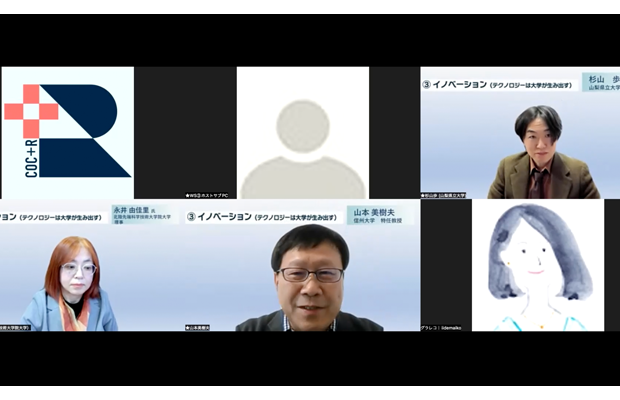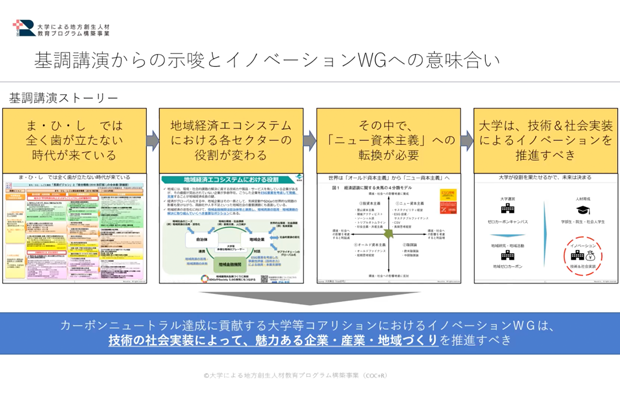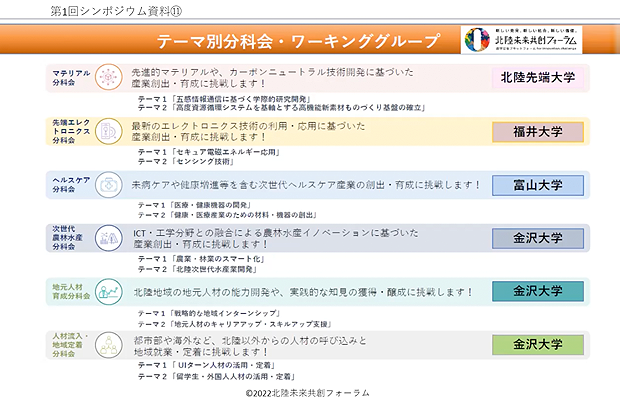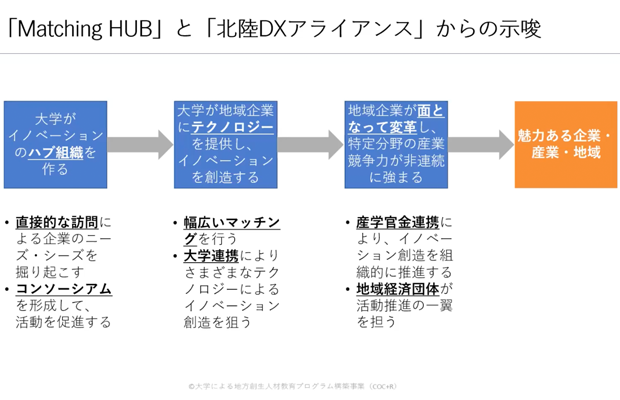Workshop 3 "Innovation (technology is created by the university)" was held under the theme of what innovation the university causes and how to establish it in the community.With Mikio Yamamoto, a specially appointed professor at Shinshu University, as a facilitator, two speakers from Japan Advanced Institute of Science and Technology and Yamanashi Prefectural University were invited to hold a panel discussion after introducing case studies.The theory of each person was developed.

What are the activities of the Innovation Working Group?
At the beginning of the workshop, facilitator Professor Yamamoto spoke the suggestions he received from the keynote speech and suggested that "social implementation of technology" was the keyword.After that, Yukari Nagai, Vice-President of Japan Advanced Institute of Science and Technology, set important social-scale goals for the activities of "Coalition of Universities to Contribute to Achievement of Carbon Neutral" (coalition, alliance). Explained that they are considering and discussing the creation of a mechanism for achieving carbon neutrality.
Among them, the Innovation Working Group promotes not only technological innovation but also social innovation such as lifestyle innovation and rule making, so that researchers and human resources from a wide range of fields gather, and universities with "comprehensive knowledge" are in the region. In, there was an explanation aiming to provide new functions (value).

Industry-academia collaboration seen in "Matching HUB Hokuriku"
Yukari Nagai, Vice President, introduced "Matching HUB Hokuriku" held in Kanazawa in November 2021 as one of the activities of the Innovation Working Group.This is an event for the creation of new industries and human resource development aimed at revitalizing the Hokuriku region, and is a matching initiative in which industry-academia-government funds from Hokuriku collaborate. It has been held since 11, and this time, "New Hokuriku created by DX and ESG" was set as one of the themes.
It is also the driving force behind the promotion of industrial digitization (RDX), a program project of the Ministry of Economy, Trade and Industry.Among the many examples of efforts, there are also research themes related to regional industries and carbon neutrality, such as innovation of the traditional craft industry with DX and utilization of unused biomass by IoT.
The university's URA (University Research Administrator) visits about 300 companies in the Hokuriku area in one year, picks up local needs and seeds, and aggregates and matches administrative and financial support.Create "seed" that leads to new products and new businesses.The process of strengthening it to generate innovation and nurturing the “bud” of the business is the role of this “Matching HUB Hokuriku”.
Industry-government-academia collaboration "Hokuriku Future Co-creation Forum" that takes advantage of the characteristics of the university
Vice President Nagai also introduced another "Hokuriku Future Co-creation Forum".At the forum, where four universities in the Hokuriku region (Fukui University, Toyama University, and Kanazawa University) and the Hokuriku Economic Federation are the main members, we are collaborating with companies to conduct various research in thematic subcommittees.
In charge of the materials subcommittee at Japan Advanced Institute of Science and Technology, selecting themes that make the best use of each university's specialty.We are advancing research and development of advanced materials, which is our strength.The current themes are research aimed at developing and implementing information and communication technology related to the five human senses, and establishing a high-performance new material manufacturing platform that leads to carbon neutrality.It is held online by connecting the three venues of Kanazawa, Toyama, and Fukui.

XNUMX steps towards attractive company / industry / community development
Next, Professor Yamamoto explained the suggestions from "Matching HUB Hokuriku" and "Hokuriku DX Alliance". A four-step process can be considered. First, the university creates a hub organization for innovation, and through direct visits, discovers the needs and seeds of companies, forms a consortium, and promotes activities. In the second stage, we provide technology and create innovation to perform a wide range of matching, and create innovation with various technologies through university collaboration. The third stage is to create innovation through industry-academia-government-government collaboration by transforming local companies as “faces” and strengthening the industrial competitiveness of specific fields discontinuously.Local economic organizations also play a role in promoting activities.And in the fourth stage, the flow is finally to transform into an attractive company, industry, and region.
He explained that such efforts in Hokuriku will be noticeable to companies and will lead to various opportunities for participation.

Not only companies and universities, but also connecting companies and companies is a major role of universities.
After the case study, it was time for discussion.Associate Professor Ayumu Sugiyama of Yamanashi Prefectural University commented on Matching HUB Hokuriku, "It is also a big point to connect companies."Vice-President Nagai also said, "The power to connect companies with each other is unique to universities." First, the companies will be energized, the universities will be energized, and society will be full of charm.He said that the solution to local issues would start from there.
Associate Professor Sugiyama, who creates value by combining plant dyeing technology with science, asked questions about the difference from similar efforts being made by local industrial support organizations.Vice-President Nagai said, "The difference from the industry-government-academia collaboration up until now is that, for example, in terms of connecting regional resources and advanced science, it is possible to open up traditional culture with chemical technology by multiplying and fusing different things. It is important. There should be both closed and open industry-government-industry collaboration, and there should be many places for companies to choose between them. "
Professor Yamamoto said, "In a sense, what is important in a disorder is the existence of curator-like editing power," and derived that this is the human resource that should be produced.It is important to take full advantage of human creativity and discover the potential for innovation from both science and art.
What is needed from now on is a "third place" that is neither a workplace nor a school.At the end of the discussion, Professor Yamamoto said that it would be great if the university could create a new one, gather people who crossed the boundaries, talk about dreams, and collaborate in various ways to lead to innovation.It was concluded that innovation shifts from creation to social retention by producing human resources unique to each region with different values from Tokyo.

